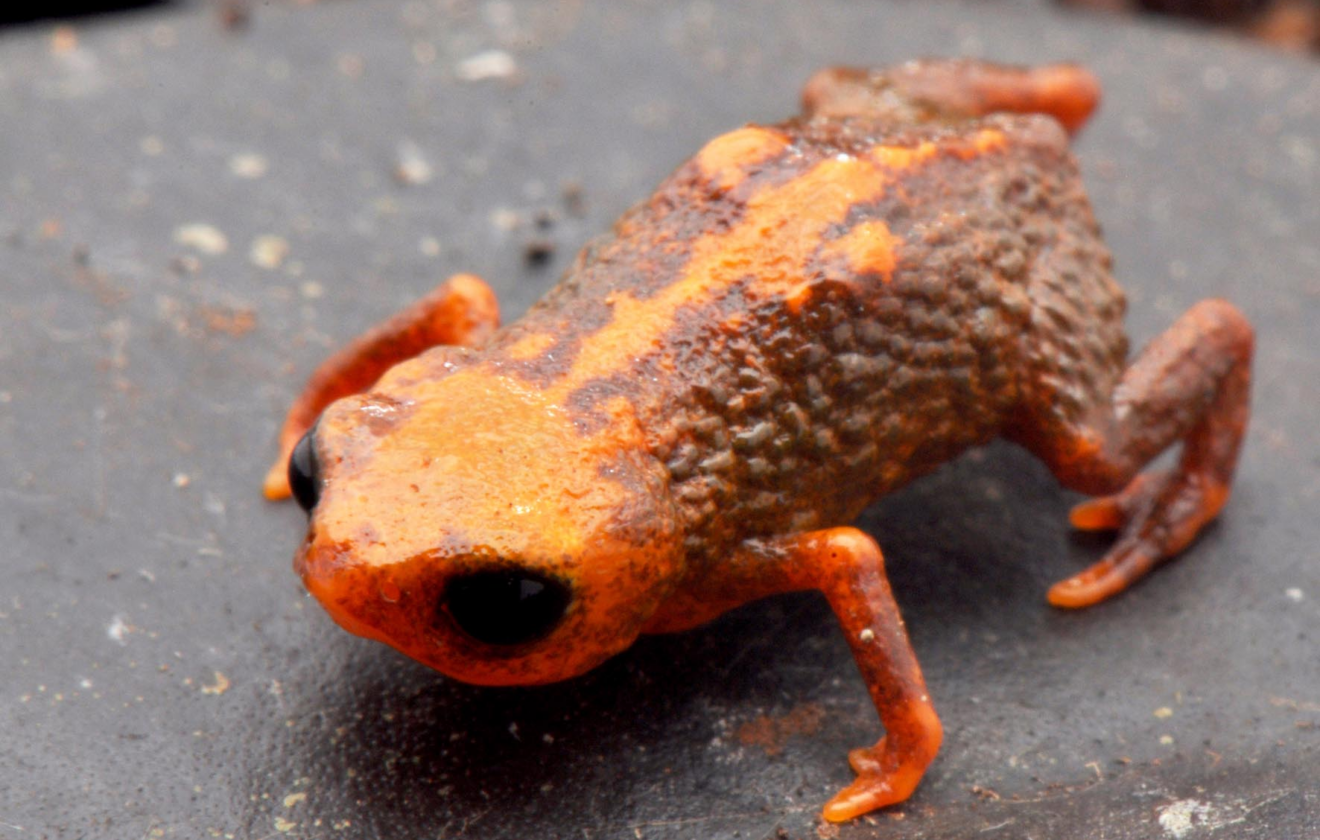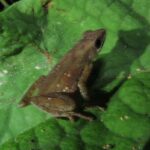- Brachycephalus quiririensis: Discovering Brazil's Exquisite Jewel of the Cloud Forest
- Taxonomy and Classification
- Natural Habitat: Secrets of the Cloud Forest
- Physical Characteristics: A Tiny Masterpiece of Evolution
- Behavior and Life Cycle
- Ecological Role: Guardians of the Forest Floor
- Threats and Conservation Status
- Cultural and Scientific Significance
- Conclusion: The Jewel We Must Treasure
Brachycephalus quiririensis: Discovering Brazil’s Exquisite Jewel of the Cloud Forest#
In the misty cloud forests that cloak the rugged slopes of southern Brazil’s Serra do Quiriri mountain range, a tiny amphibian of remarkable beauty and ecological significance dwells hidden amidst the leaf litter. This radiant jewel of nature, known scientifically as Brachycephalus quiririensis, is no ordinary frog. Despite measuring barely a thumbnail’s length, its vivid coloration, intriguing behaviors, and unique adaptations make it a captivating symbol of biodiversity, offering significant insights into ecosystem health and conservation.
Belonging to an enigmatic genus of miniature frogs known as Brachycephalus, this species was described as recently as 2015 by a dedicated team of Brazilian researchers unveiling new wonders amid dense tropical greenery. Yet, in such a short time, Brachycephalus quiririensis has rapidly become a cherished character in the narrative of amphibian research, biodiversity exploration, and environmental protection. Let’s delve deeply into this captivating amphibian’s life, habitat, and ecological importance, discovering why protecting this tiny creature matters greatly in our quest to preserve our planet’s diversity.
Taxonomy and Classification#
Brachycephalus quiririensis belongs to the family Brachycephalidae, a lineage of frogs notable for their uniquely reduced body size and specialized ecological adaptations. This family, consisting of miniature, bright-colored species, showcases some of nature’s most fascinating evolutionary strategies. Within the genus Brachycephalus alone, there are several closely related species that share a similar cryptic lifestyle, specialized physiological features, and dazzling pigmentation. Such diversification highlights evolutionary processes shaped by intricate ecological pressures in isolated mountainous habitats.
This amphibian was officially described in a 2015 paper by scientists who ventured into the remote highland forests of Santa Catarina state in Brazil. The Serra do Quiriri region emerged as a hotspot for biodiversity, harboring this diminutive frog and other previously undescribed amphibians. Within the genus, close relatives include species such as Brachycephalus mariaeterezae and Brachycephalus boticario, similarly known for their tiny statures and vibrant appearances. Researchers use mitochondrial DNA analyses and morphological traits—such as skin texture, bone structure, and pigmentation patterns—to distinguish Brachycephalus quiririensis from its equally vivid cousins.
Natural Habitat: Secrets of the Cloud Forest#
Venture into the cloud forests blanketing Brazil’s Serra do Quiriri, and there, within a realm where fog cloaks ancient trees and bromeliads drip gently with moisture, resides Brachycephalus quiririensis. Strictly endemic, this tiny frog has adapted exquisitely to life amid the high-elevation Atlantic Forest biome—a biome known for biodiversity hotspots tucked away among misty mountain ridges.
The species favors elevations typically between 1,200 to 1,500 meters above sea level, within lush montane forests where sunlight rarely penetrates fully, gifting the forest floor an eternal twilight. Beneath the shade of thickly interwoven branches, these frogs can be found navigating amid leaf litter, fallen logs, moss carpets, and the moist undergrowth of bromeliads—all vital microhabitats providing temperatures and humidity ideal for survival.
The humid microclimate, typical of cloud forests—where frequent mist sweeps across the foliage, keeping conditions perpetually damp and cool—has shaped the conditions necessary for this frog’s delicate skin and unique physiological adaptations. Researchers emphasize the species’ high specialization to these niche environments, underscoring the importance of preserving these habitats to ensure the survival of this elusive creature.
Physical Characteristics: A Tiny Masterpiece of Evolution#
At first glance, one might mistake Brachycephalus quiririensis for a brightly painted gemstone dropped amid fallen leaves. Adults measure only around 10–13 millimeters—approximately the size of a fingertip—making them among the world’s smallest amphibians. Despite their minute stature, their colors are astonishingly bold and vivid; bright yellows, oranges, and reds blanket their compact bodies, offset by dark eyes that reflect the filtered sunlight peeking through the thick canopy above.
Distinctively, these frogs possess shortened appendages and rounded bodies, adaptations ideal for their terrestrial lifestyle amid dense vegetation and slippery leaf litter. Their fingers and toes are notably reduced, devoid of adhesive pads typical of tree-dwelling amphibians, reflecting their strictly terrestrial habits. This diminutive species lacks vocal sacs typically found in larger frogs, suggesting fascinating adaptations in their communication and reproductive behaviors.
The vibrant coloration of Brachycephalus quiririensis serves as aposematic (warning) signaling, indicating their possession of toxic alkaloids in the skin. These compounds deter predators effectively, a crucial adaptation in habitats rich in predatory invertebrates and avian species foraging in leaf litter. Researchers highlight that such chemical adaptations in small frogs represent an evolutionary innovation, crucial for thriving in micro-ecosystems with numerous predators and competitors.
Behavior and Life Cycle#
Cryptic Lives in Leaf Litter#
This species exhibits intriguing behaviors cloaked by the sheltering shadows of the cloud forest. Largely diurnal, the frogs actively forage during daylight hours, carefully navigating leaf litter in search of tiny arthropods like mites, ants, springtails, and minute flies. Their keen eyesight, complemented by acute sensory capabilities, aids these tiny predators as they hunt prey hidden beneath a complex mosaic of decomposing leaves and soil.
Mating and Reproduction#
Little is currently understood about their mating behaviors in detail due to the logistical challenges of field observations in dense forest environments. However, scientists speculate reproductive cycles are tied closely to seasonal climate patterns, with the breeding season typically corresponding to periods of ample rainfall.
Similar to other frogs within the genus, Brachycephalus quiririensis is presumed to exhibit direct development—bypassing the typical aquatic tadpole stage. Females lay small clutches of eggs hidden beneath damp leaves or logs, safeguarded from desiccation by habitat-specific conditions. Upon hatching, miniature froglets appear as scaled-down versions of adults; fully terrestrial and perfectly adapted from day one.
Ecological Role: Guardians of the Forest Floor#
Brachycephalus quiririensis occupies the delicate role of predator and prey, maintaining ecological balance within the intricate cloud forest food webs. By preying upon microscopic arthropods, they contribute significantly to regulating populations of decomposer organisms within the ecosystem. Likewise, their various predators—including spiders, centipedes, and small birds—depend on them as vital components of their diet, completing vital links between trophic levels.
Moreover, owing to their sensitivity to environmental changes, these amphibians serve as ecological sentinels. They are among the first indicators of ecosystem health, warning conservationists when conditions shift toward imbalance or degradation.
Threats and Conservation Status#
While relatively new to science, the survival of Brachycephalus quiririensis already faces significant uncertainties. Habitat fragmentation, deforestation for agricultural and urban expansion, and climate change-induced shifts in temperature and humidity threaten its delicate habitat. Currently, Brachycephalus quiririensis remains unlisted by the IUCN due to its recent discovery; nonetheless, scientists voice concerns about habitat vulnerability and limited distribution.
Local conservation initiatives, including habitat protection, biological corridor restoration, and awareness campaigns, are imperative to sustaining viable populations. Conservationists stress the importance of community engagement and educational outreach in supporting effective conservation strategies for this frog and its fragile habitat.
Cultural and Scientific Significance#
This tiny ambassador of the cloud forest symbolizes the profound complexity and value of preserving unexplored ecosystems—their biodiversity represents untapped potential in medicine and ecological balance. Biochemists demonstrate an increasing interest in researching amphibian skin toxins for potential biomedical applications, making preservation efforts even more crucial.
Conclusion: The Jewel We Must Treasure#
To witness the tiny brilliance of Brachycephalus quiririensis is to glimpse nature’s intricately woven tapestry. Protecting such creatures ensures not merely their survival, but the health and sustainable future of habitats integral to global biodiversity.
Let us champion efforts to conserve this miniature wonder, pledging to sustain ecosystems that foster magnificent life like Brachycephalus quiririensis, for their story is fundamentally interconnected with our own.












